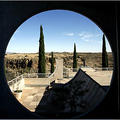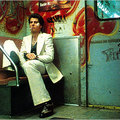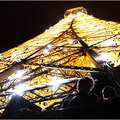THE Statue of Liberty, as you'd probably guess, is a New York City landmark. It is protected by law from modernizing scalawags who might want to pound windows into the folds of her gown or build tacky balconies for patriotic sunbathing.
Same with the New York Stock Exchange (sorry, no adding busts of Google's founders, Larry Page and Sergey Brin) or the Tweed Courthouse (carving hieroglyphs into the pillars is prohibited).
But nobody needs to alert visitors to their presence. They're visible from afar, and you're hardly likely to miss them unless fog rolling in off the Atlantic becomes very, very thick.
The city's smaller landmarks, though, are harder to spot, hidden on side streets that most visitors would only wander down by chance, or camouflaged by the more ordinary (and often taller) buildings that surround them. You'd walk past many of them unless you happened to stop right across the street, then suddenly took a 90-degree turn.
But by missing them, you're giving up on the city's architectural amuse-bouches while pigging out on the grander sights. So along with your Fodor's or Frommer's or Lonely Planet guides, consider taking along the city's paperback Guide to New York City Landmarks, with maps and summaries of hundreds of such spots (along with descriptions of the superstars, too). Sure, the latest edition was published in 2004, which by regular standards would be woefully inaccurate, but this is a guidebook that, by definition, never goes out of date (although new landmarks are added every year).
Even without the book, for example, you might catch a glimpse of the colorful onion domes of the Central Synagogue, a Reform temple built on Lexington Avenue in the 1870s, following a Moorish-style synagogue-building trend that started in Germany and arrived in New York via Cincinnati. But you'd miss the two landmarked buildings that are the synagogue's neighbors on otherwise nondescript East 55th Street.
At No. 116-118, there's a neo-Georgian house from 1927 that has Flemish-bond brickwork, elegant shutters and two carved eagles guarding the entrance. And at No. 124, the Mary Hale Cunningham House, renovated with a neo-Tudor facade in 1909, has perplexing signs attached to the second-story railing that read “Eleanor's Building” and “She Who Must Be Obeyed.” Turns out those were put up there in 1983 (before the house was landmarked) as a fanciful tribute to the wife of the owner of a television production company based in the building.
The West Village is thick with landmarks, especially since a huge chunk of it is part of the Greenwich Village Historic District. The book picks out several can't-miss (but easy to miss) buildings. There is, for example, the spare but elegant Federal-style triangular building stuck in the middle of an intersection of Waverly Place and Christopher Street with the battered signs that read “Northern Dispensary, Founded 1827.”
It looks like the kind of place where Ben Franklin or Sam Adams might have hung out, but it was a clinic for the poor. The book says that it was built in two stories, but a third story was added in 1855; if it didn't, you'd never notice that the third-story bricks are just a bit different from those of the second.
Also in the Village, you might never go down East 10th Street from Fifth Avenue to check out the Lockwood de Forest House, which is now part of New York University, at No. 7. But its intricately detailed teak on the second-floor facade, brought in from Ahmadabad, India, in the late 19th century, is amazing. And you'd never end up at the far western end of cobblestoned Jane Street to check out the American Seamen's Friend Society Sailors' Home and Institute, a hotel for indigent sailors that was host to crew members who survived the sinking of the Titanic. There's another reason to visit these days; the building is home to Socialista, a new upscale Cuban lounge that has a downstairs restaurant.
If you're near Macy's or the Empire State Building, the East 30s have a nice batch of landmarks, including the town houses of the Murray Hill Historic District. But on 36th Street between Lexington and Third Avenues, a block you would be strolling down only by blind luck, is hidden Sniffen Court, a quaint private alley of former horse stables built starting in 1863 and now inhabited by well-off humans.
Or the supercool wooden doors at the James F. D. and Harriet Lanier House at 123 East 35th Street, built between 1901 and 1903 in the Beaux-Arts style. Gaze at it from across the street, where your view will only be slightly corrupted by the significantly more contemporary Muni-Meter parking ticket machine. (The sidewalk is apparently not protected by the landmarks law.)
As you wander past these buildings, the question that will gnaw at you is: “Who the heck lives there?” But surprisingly often, you'll catch real people (not dressed in period attire) coming in and out of the buildings. Who are they? How did they end up in the house? Perhaps they won't appreciate your stopping them to ask about the house, but that's one way to find out.
VISITOR INFORMATION
Guide to New York City Landmarks, Third Edition (Wiley, 2004, $26.95). Maps of the historic districts (but not the individual landmarks) are available at www.nyc.gov/landmarks.
A few more worth a detour:
The former German-American Shooting Society Clubhouse, 12 St. Marks Place, between Second and Third Avenues, an 1889 German Renaissance building.
An 1858 house at 152 East 38th Street, between Lexington and Third Avenues, set dramatically back from the street, and 149 East 38th Street, an ornate stable building in the Dutch Renaissance Revival style.
The former William J. Syms Operating Theater of Roosevelt Hospital, 400 West 59th Street, at Columbus Avenue.
Five townhouses from 11 to 21 (odd numbers) East 70th Street, between Fifth and Madison Avenues, near the Frick Collection (itself in a landmark building).







